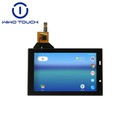Capacitive touchscreens are widely used on handheld devices such as smartphones, tablets, gaming devices, and other devices with display screens. These screens have revolutionized the way users interact with technological devices by providing accurate, reliable, and highly responsive touch input interfaces. The technology has been around since the late 1960s, but it wasn't widely used due to the high cost and limitations in manufacturing methods. However, with the decrease in manufacturing costs, capacitive touchscreens have become the norm on handheld devices, replacing the traditional resistive touchscreens.
Capacitive touchscreens operate on the principle of capacitance. Capacitance is the ability of a material to store an electrical charge. In a capacitive touchscreen, two layers of conductive materials, typically Indium Tin Oxide (ITO), are separated by a thin dielectric layer. When the user touches the screen with their finger or a stylus, they create a conductive path between the two layers. This creates a change in the electric field, which is sensed by a controller chip, which calculates the location of the touch.
One of the significant benefits of capacitive touchscreens is their high sensitivity and accuracy. They can detect even the slightest touch, making them ideal for tasks such as typing on touch keyboards, navigating through menus, or playing games. They are also immune to scratches and other physical damage, which makes them durable and long-lasting. Capacitive touchscreens are also responsive to multi-touch gestures, allowing users to zoom, pinch, and rotate images effortlessly.
Another significant advantage of capacitive touchscreens is their high contrast and brightness. The screens produce bright, vivid colors, making them ideal for applications such as video playback, gaming, and web browsing. Capacitive screens are also energy-efficient, consuming less power than other touch screen technologies, which contributes to longer battery life on handheld devices.
However, there are some drawbacks to capacitive touchscreens. One is that they require the use of a conductive material, such as a finger or stylus, to activate them. This can be a problem for users wearing gloves or using non-conductive objects to interact with the screen. Additionally, capacitive touchscreens are more expensive than other touchscreen technologies, which can increase the cost of handheld devices for consumers.
In conclusion, capacitive touchscreens have become a game-changer for handheld devices, providing an intuitive, accurate, and reliable touch input interface. They offer high sensitivity, accuracy, contrast, and brightness, making them ideal for a wide range of applications such as gaming, browsing, and video playback. While they may have some drawbacks, the benefits of capacitive touchscreens make them an indispensable part of modern handheld devices.





